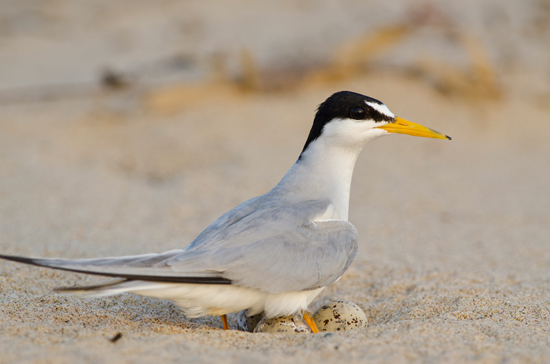BY
FRANKFORT, Ky. – Interior least terns are nesting now on sand bars in the Mississippi River along the New Madrid Bend, the western most parcel of Kentucky. Least terns are the only endangered species that nests in our state. Human disturbance can heavily impact their nesting success.

“Once the Ohio River drops a little, they will nest there as well,” said John Brunjes, migratory bird biologist for the Kentucky Department of Fish and Wildlife Resources. “Least terns need clean sand bars free of weeds to nest.”
Brunjes and other workers mark the least tern nesting areas with yellow signs to warn people. The least tern nests on the Mississippi River along Kentucky’s western border and in the Ohio River from Paducah downstream.
“If you see yellow signs on a river sand island, then stay off,” Brunjes said. “With the Ohio River dropping, some terns will nest before we can mark them. If you see least terns circling, then stay away.”
Clean sand bars draw the least terns to nest, but they also look like a beach, which attracts boaters, swimmers, campers and all terrain vehicle riders.
“Any human disturbance will cause the adult to abandon the nest,” Brunjes explained. “The adult squats on the nest and provides shade for the small eggs and chicks until they are old enough to regulate their own body temperature.”
Brunjes explained the summer sun beaming on unprotected least tern nests raises the sand temperature to between 120 and 130 degrees, which is fatal to eggs or chicks.
“If you pull up on a sand bar in these rivers and see little white birds circling above you, then you’ve likely disturbed a least tern nest,” Brunjes explained. “If you throw out an anchor, they will abandon the nest if you are too close.” Least terns are white sparrow-sized birds with light gray wings and black markings on their heads.
“If you flush least terns off a nest, crows or other avian predators will steal the eggs to eat,” Brunjes said. “Also, until the day they can fly, they will get in the river when frightened and trying to escape. The current takes them away and they drown.”
Not only will the summer sun bake an unprotected least tern nest, wind-blown sand will quickly fill it. The adult then can’t find the nest.
Least tern nests on a river sand bar are difficult to detect. “They are about the size of a silver dollar with three little dime-sized eggs,” Brunjes said. “The nests are camouflaged really well and you can step on them easily. If you step on the nest, the adult will abandon it.”
Riders on all terrain vehicles can destroy many nests by accidentally running over them. “If you cause a least tern nest to die, that is considered take under the Endangered Species Act,” Brunjes said. “You may be fined up to $100,000.”
The law enforcement divisions of the U.S. Fish and Wildlife Service and Kentucky Fish and Wildlife know the location of the nests and are monitoring them carefully.
The incubation period lasts 23 days for least terns and they take two to three weeks to learn to fly. Nest incubation is shared among the male and female least tern. When not sitting on the nest, the male least tern secures insects or small fish for the female to eat.
“We have over 1,000 nests in Kentucky annually,” Brunjes said. “Ten percent of the world’s population of interior least terns nests here. It is important that we protect them.”
Author Lee McClellan is a nationally award-winning associate editor for Kentucky Afield magazine, the official publication of the Kentucky Department of Fish and Wildlife Resources. He is a life-long hunter and angler, with a passion for smallmouth bass fishing.
-30-
The Kentucky Department of Fish and Wildlife Resources manages, regulates, enforces and promotes responsible use of all fish and wildlife species, their habitats, public wildlife areas and waterways for the benefit of those resources and for public enjoyment. Kentucky Fish and Wildlife is an agency of the Tourism, Arts and Heritage Cabinet. For more information on the department, visit our website at fw.ky.gov.


Be the first to comment